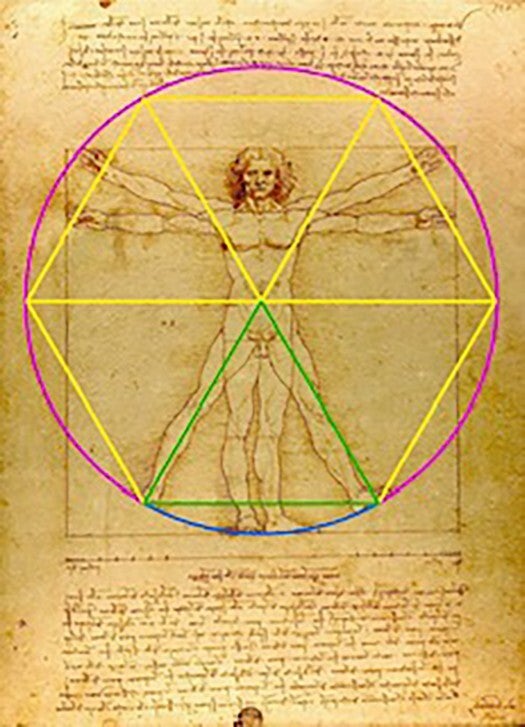A London-based dentist has uncovered a hidden detail in Leonardo da Vinci’s famous Vitruvian Man drawing, revealing a special number connecting the iconic artwork to the human body and nature.
The discovery, described in the Journal of Mathematics and the Arts, reveals how the legendary Italian polymath perfectly placed the Vitruvian Man human figure inside a circle and a square.
An equilateral triangle “hidden in plain sight” within Leonardo’s notes could be a clue to his construction method, which laid the foundation for the drawing’s proportional choice, says Rory Mac Sweeney, dentist and author of the study.
The triangle can be found between the man’s legs in the artwork, and “isn’t just a random shape”, Dr Sweeney says.

This shape matches one found in modern anatomy known as “Bonwill’s triangle”, which explains how human jaws work in the most efficient way, he says.
The imaginary equilateral triangle is formed by connecting the centres of the points where the lower jaw connects to the skull, and the midpoint of the mandible’s central incisors.
The length of each side of Bonwill’s triangle is generally equal in most individuals, at about 4 inches or 10 cm, and is used in dentistry to understand and analyse the anatomy and mechanics of the jaws.
This measure helps design proportional dentures and position them for proper bite alignment.
The use of such a triangle in Leonardo’s art suggests the Italian polymath likely understood this ideal design of the human body centuries before modern science, Dr Sweeney suspects.
Using such an equilateral triangle in the Vitruvian Man drawing helps produce a specific ratio – 1.64 – between the size of the square and the circle in the artwork.

This ratio is almost identical to a “special blueprint number” 1.633, which appears frequently in nature for building the most efficient structures, such as the atomic structure of super-strong crystals, and the tightest way to pack spheres, like stacking oranges at the supermarket.
“Leonardo’s systematic construction yields a ratio of 1.64 to 1.65 between the square’s side and circle’s radius, matching both published measurements of the original drawing, and the tetrahedral ratio of 1.633 found in optimal spatial arrangements,” the study noted.
“We’ve all been looking for a complicated answer, but the key was in Leonardo’s own words. He was pointing to this triangle all along,” Dr Sweeney said.
The discovery hints that the Vitruvian Man painting is not just a beautiful piece of art, but also a scientific work centuries ahead of its time.
“What’s truly amazing is that this one drawing encapsulates a universal rule of design. It shows that the same ‘blueprint’ nature uses for efficient design is at work in the ideal human body,” Dr Sweeney said.
“Leonardo knew, or sensed, that our bodies are built with the same mathematical elegance as the universe around us,” he added.

